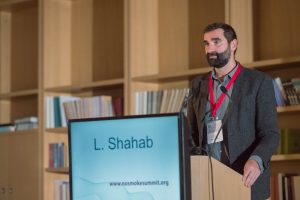Using a nicotine vaping product remains the most popular aid used in a quit attempt, and there is strong evidence that these products are effective for smoking cessation and reduction. However, there is a growing “fear” that tobacco harm reduction policies will encourage the uptake of vaping and thus addiction to nicotine by youth.
In his keynote speech, chaired by Professor Konstantinos Farsalinos, Dr. Lion Shahab from UK presented evidence on this subject and discussed the importance of the new challenge that needs to be addressed: the difficulty of encouraging and establishing Harm Reduction while protecting youth from adopting the use of nicotine.
Harm Reduction has been accepted by governments around the world for almost everything else (e.g. intravenous drug use, alcohol, car and motorcycle accidents) besides tobacco and smoking, Professor Konstantinos Farsalinos said. In smoking, Harm Reduction is a very controversial issue and an issue of debate for many years, because of the risk that available alternative to cigarettes new products can become quite popular among youth and non-smokers, increasing addiction to nicotine, he explained, welcoming and presenting Professor Lion Shahab, an expert in the field of Tobacco Harm Reduction and Tobacco Control.
The rationale behind the Tobacco Control Harm Reduction approach, Professor Dr. Lion Shahab underlined at the beginning of his speech, is that, despite 70+ years of research; thousands of reports by health authorities; hundreds of health promotion campaigns; numerous legislative changes and smoking cessation interventions being implemented, there are still smokers who cannot or are not willing to quit smoking.
Tobacco Control strategies aim to reduce the harm caused by tobacco use by reducing participation in tobacco use and uptake and increasing cessation, he said, presenting consequently evidence about the health impact and effectiveness of different alternative to combustible cigarettes products, such as snus, heated tobacco products and e-cigarettes.
There is strong evidence that nicotine vaping products are really effective for smoking cessation and reduction, Professor Shahab said, mentioning the results from a UK study according which EC use increases significantly the quit attempts success.
Unfortunately, he continued, the evolution of e-cigarettes during the years, from the disposable “cigalikes”, to refillable tank, prefill pods and the newer disposable “bars”, has changed its usage patterns and has led to a very pronounced increase of use of e-cigs by the youth compared with older ages. According to the results of a recent survey, he added, e-cigarette use overall has increased significantly and for the first time seems to overtake cigarette use in UK.
Young adults are particularly vulnerable to become addicted because they are more easily swayed by peer pressure and external influences such as marketing and their developing brain is affected more strongly by exposure to addictive substances.
A reason for concern in youth is the gateway concept, according which there is a possibility for a causal progression from initiated in adolescence legal/“soft” use to illicit/“hard” polydrug use, but evidence for gateway are actually still rather weak, Dr. Shahab said. The gateway concept is problematic because it requires a counterfactual scenario to be tested, he explained, adding that, if e-cigarettes divert more youth from smoking than they recruit into smoking, then their use is net positive, although we cannot exclude the possibility new products to change this equilibrium.
Still, at this point, Professor Lion Shahab concluded his speech, there is clear evidence that e-cigarettes (but also snus and other reduced harm products) are beneficial for existing smokers with little evidence of gateway effects. Of course, to engage smokers and youth correctly, we need accurate information/legislation, favoring e-cigarettes over cigarettes, while reducing lifestyle appeal. Encouraging smokers and kids who would smoke anyway to use EC while preventing in parallel EC use among kids who would have never smoked, he mentioned, is a complicated task not easy to be achieved. A key thing to remember is that the risk of uptake of EC is less important in a climate where cigarettes are still widely available and used. Of course, once in the endgame, Professor Shahab said, proven tobacco control strategies should be applied to phase out unnecessary use of reduced risk products.
It is indeed a really complicated task to find the right balance, agreed Professor Farsalinos, mentioning that Public Health sector policies seem to move towards a Nicotine Control target instead of Tobacco and Smoking Control. Nicotine is of course addictive, Professor Shahab said, but nowadays we should be more concerned about cigarettes-addiction and not nicotine-addiction. We must remember that cigarettes are still in the market and are very dangerous, much more than nicotine alone. We need regulations, but we cannot be a priori negative and manipulate information because we don’t want people to use these new products· we must provide people with full and accurate information. Manipulation of information is not ethical and eventually can cause harm, concluded Dr. Shahab.


